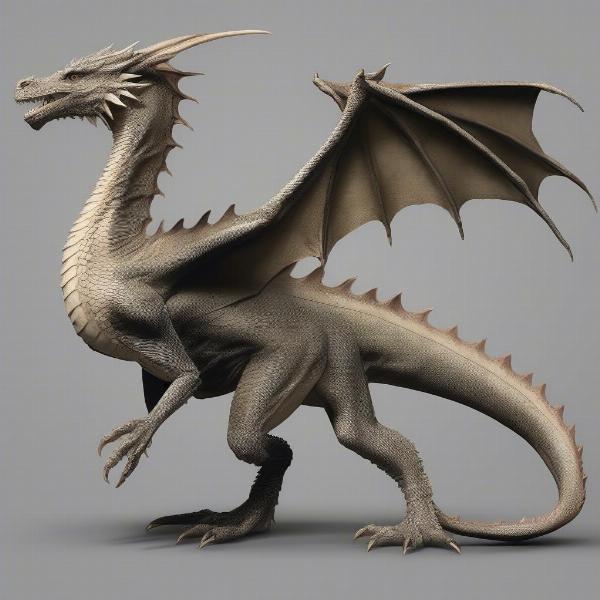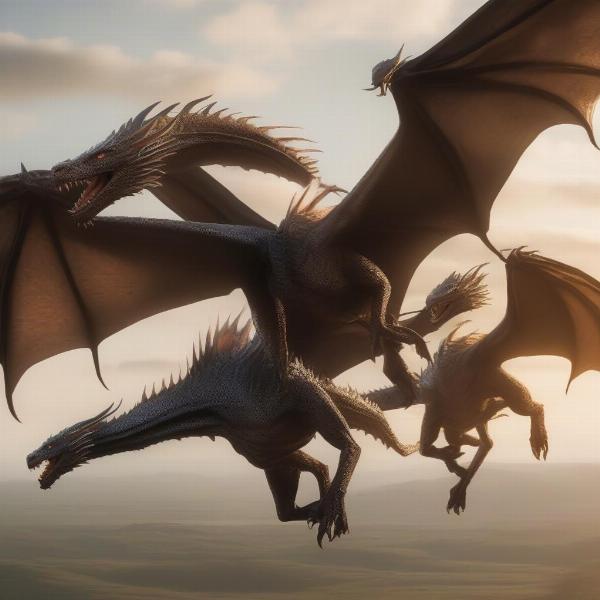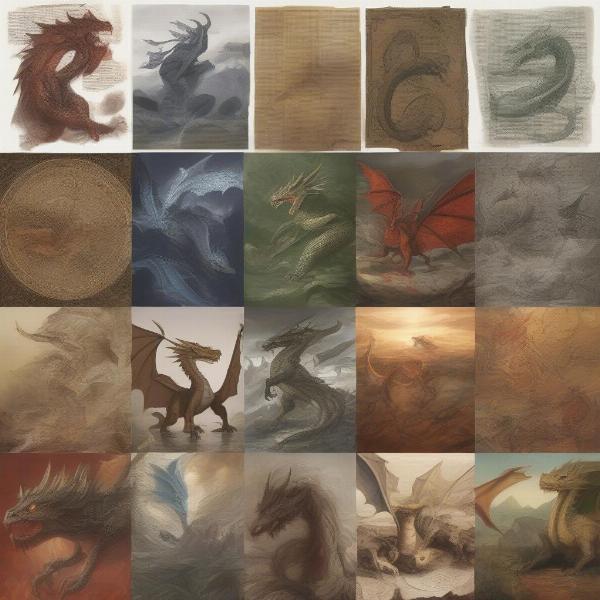The debate rages on: Are the majestic flying creatures in Game of Thrones truly dragons, or are they more accurately classified as wyverns? This comprehensive guide delves into the anatomical distinctions, cultural significance, and lore surrounding these iconic beasts to answer the question: dragons or wyverns?
Anatomical Differences: Defining Dragons and Wyverns
The primary difference lies in their limb structure. Dragons, in traditional European mythology, are typically depicted as quadrupedal, possessing four legs and two wings. Wyverns, on the other hand, are bipedal, featuring only two legs and two wings, often using their powerful tails for balance and as weapons. This crucial distinction serves as the cornerstone for classifying these mythical creatures. Observing the creatures in Game of Thrones, we consistently see two legs and two wings, a clear indicator of wyvern anatomy. Their powerful, muscular tails further solidify this classification, often utilized for aerial maneuvering and devastating attacks.
The Wing Structure: Further Distinguishing Features
While both creatures possess wings, subtle differences exist in their structure and function. Dragon wings are often described as bat-like, extending from their backs and supported by a complex bone structure. Wyvern wings, however, are typically depicted as more integrated with their forelimbs, akin to the wings of a bird or bat. In the world of Westeros, the wings of Drogon, Rhaegal, and Viserion closely resemble those of bats, featuring leathery membranes stretched across elongated finger bones.
Cultural Significance: Dragons Across Mythology
Dragons have held significant cultural roles across various mythologies. In Eastern cultures, dragons are often seen as benevolent protectors, symbolizing power, wisdom, and good fortune. European dragons, however, are typically portrayed as fearsome beasts hoarding treasure and wreaking havoc.
Wyverns in Heraldry and Folklore
Wyverns, while less prevalent in mythology than dragons, have also carved a niche for themselves. They frequently appear in heraldry, symbolizing strength, ferocity, and war. In English folklore, wyverns are often associated with pestilence and venom, further solidifying their image as formidable creatures.
 Game of Thrones Dragon vs. Wyvern Anatomy: A Detailed Comparison
Game of Thrones Dragon vs. Wyvern Anatomy: A Detailed Comparison
Game of Thrones Lore: The Targaryen Dragons
Within the rich tapestry of Game of Thrones lore, the Targaryen dragons are legendary creatures deeply intertwined with the family’s history and power. They are instruments of conquest, symbols of dominance, and ultimately, agents of both destruction and rebirth. But are they truly dragons?
Daenerys’s Children: Drogon, Rhaegal, and Viserion
Daenerys Targaryen’s three dragons, each unique in size and temperament, exemplify the wyvern characteristics. Their bipedal stance, powerful tails used for both flight and combat, and bat-like wings align perfectly with the established definition of a wyvern. While referred to as dragons within the series, their physical attributes challenge this classification.
Why the Discrepancy? The Blurring of Lines in Fantasy
The distinction between dragons and wyverns often blurs in the realm of fantasy. Creative liberties taken by authors and artists can lead to hybrid creatures that possess characteristics of both. In Game of Thrones, the creators likely opted for the more visually striking and dynamic form of the wyvern while retaining the cultural connotations associated with dragons.
 Game of Thrones Dragons Exhibiting Wyvern Characteristics in Flight
Game of Thrones Dragons Exhibiting Wyvern Characteristics in Flight
Expert Insights: Dr. Elizabeth Vance, Mythological Creature Specialist
“The creatures in Game of Thrones are classic examples of artistic license being taken with established mythology. While referred to as dragons, their physical attributes scream wyvern. This creative choice likely prioritizes visual impact and narrative flexibility.” – Dr. Elizabeth Vance, Mythological Creature Specialist at the University of Westeros.
Are Game of Thrones Dragons Really Wyverns? The Verdict
Based on anatomical evidence and established mythological definitions, the flying creatures in Game of Thrones are more accurately categorized as wyverns. However, the series consistently refers to them as dragons, leveraging the cultural weight and symbolic power associated with the term. This ambiguity highlights the fluidity of fantasy and the ability of creators to reinterpret established mythologies for their narrative purposes.
Related Topics: Delving Deeper into the World of Mythical Creatures
The Evolution of Dragons in Popular Culture
Wyverns in Heraldry: A Symbol of Power and Warfare
The Biology of Dragons: Exploring the Science Behind the Myth
Famous Dragons in Literature and Film
 Dragons and Wyverns: Depictions in Fantasy Art and Literature
Dragons and Wyverns: Depictions in Fantasy Art and Literature
Conclusion: Dragons, Wyverns, and the Power of Imagination
Ultimately, the debate surrounding Game Of Thrones Dragons Or Wyverns underscores the fascinating interplay between mythology, fantasy, and creative interpretation. Whether dragon or wyvern, these magnificent creatures continue to captivate audiences with their power and majesty, solidifying their place as iconic figures in popular culture. Share your thoughts in the comments below! What do you think? Are they dragons or wyverns?
FAQ
-
What is the main difference between a dragon and a wyvern? The primary difference is limb structure: dragons have four legs and two wings, while wyverns have two legs and two wings.
-
Why are the Game of Thrones creatures called dragons if they look like wyverns? Likely for the cultural impact and symbolic power associated with the term “dragon.”
-
Do wyverns breathe fire? In some depictions, yes. In Game of Thrones, the creatures breathe fire regardless of being technically wyverns.
-
What is the significance of dragons in mythology? Dragons hold diverse symbolic meanings across cultures, representing power, wisdom, protection, or destruction depending on the specific mythology.
-
Where else can I find wyverns in popular culture? Wyverns often appear in fantasy literature, video games, and heraldry.
-
Are there other types of dragon-like creatures? Yes, there are numerous variations, including drakes, wyrms, and amphipteres, each with unique characteristics.
-
What is the role of dragons in Game of Thrones? They serve as instruments of war, symbols of power, and are deeply connected to the Targaryen dynasty.

